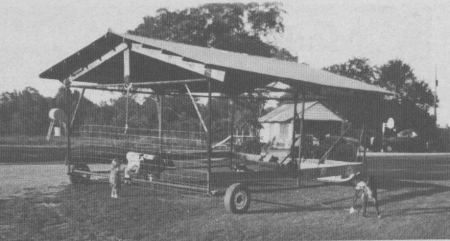
"It lets me keep calves dry and clean without having to use any bedding," says Scott Jennette, Bee Branch, Ark., about the 16-ft. wide, 20-ft. long rolling "barn" he made for his dairy calves.
The open-sided shelter consists of a steel frame made from drill stem with a pair of wheels mounted on back. It has a tin roof on top with a 2-ft. overhang. Wooden boards bolted to the front and sides keep calves in. A 4-ft. long feed trough (made from an old hot water heater) and 5-ft. long milk trough (made from a men's urinal) mount in front. The back end of the shed is covered by a wire panel gate that swings open. To move the barn, Jennette hooks the lower arms of his tractor 3-pt. onto the front of the barn, lifts, and then drives away slowly.
"I move the barn to a clean place whenever the grass runs out so calves always have fresh grass to eat. It has reduced death losses to just about zero. I keep about 7 calves inside the barn at a time.
"I keep calves grouped according to size and age. They go into the rolling barn as soon as they learn how to drink milk from a bucket -- when they're about 1 1/2 weeks old. They stay in it until they start eating good about 6 weeks later. Then I put them out to pasture.
"I usually park it near my milk barn so I don't have to walk far to feed them. I use buckets to put feed and milk in the troughs. A wire panel placed in front of the troughs keeps any cows that get out of their pasture from eating the calves' feed. I use a hose next to my milk barn to fill a 5-gal. bucket of water that I place inside. I bottle-feed young calves tied to the outside of the rolling shed for five or six days until they learn how to drink from a bucket, then move them inside.
"I originally built my portable barn to cover piles of cottonseed that I was feeding to dairy cattle. When I'm not using it for calves I use it as a garage. I've even put a picnic table inside it and used it for a birthday party."
